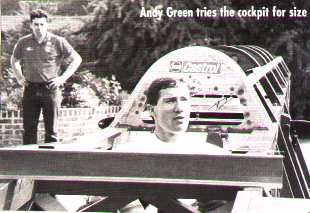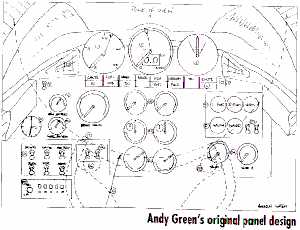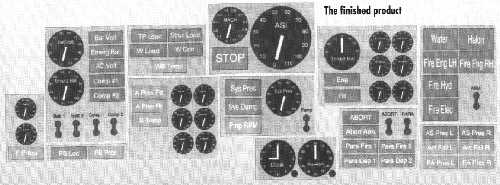
Phil Goss and Mike Lowman have continued their work on the structural hoops that will support the bodywork over the two engines. These hoops mount onto the outer sill members via fabricated anchor points and span up and over the engines to their inboard point on the upper chassis rail via a second anchor point. These hoops are removable to allow for engine removal or access. They have been a major labour of love, particularly for Phil, who has had to form them by hand over blocks supplied by Mike Horne who is overseeing the entire bodywork programme. We have received great assistante from a local company, Cunningham Boatbuilders in Littlehampton, who have a shrinking machine with the capacity suitable for the 2.5mm thick aluminium material used.
Mike Horne has since built up each hoop from its six individual components and mounted them all, starting on the rearmost station on the right-hand engine bay. At long last we can see the final shape emerging and get a real feel for what the car will look like when complete. Believe me - it's going to be fantastic!
Mike Curran has joined the Team. Mike was a senior stressman at Westlands before 'going solo'. He has been looking over the total loading package of the car translating Ron Ayers' basic research numbers into stresses and strains. Thus he can select panel thickness and structural requirements. He has started in the cockpit area ensuring that the canopy and windscreen areas are up to the job. He has now begun work on the tailplane and fin and has very quickly assimilated the basic loadings from Ron's figures and turned them into a surprisingly simple structural requirement which can be rapidly turned into the components. Having someone of Mike's experience and talent is a major asset to the programme.
After a couple of frustrating false starts, the patternwork for the nose section and nacelles is now fully underway. We have arrived at a situation where workload is being split by a number of companies. The nose pattern is being mnde by Daewoo, the Korean car manufacturer, at their Technical centre in Worthing. Daewoo are supplying everything free of charge, which is a tremendous boost. The nacelles are being made by Survirn Engineering in Birmingham. We are doing the blocking up for the tools which are being made from MDF board very generously supplied by Caberboard Ltd in Stirlingshire. Mike Horne has taken on the task of the blocking up process which is an enormous project. When finished, they were sent up to Birmingham where Survirn machined them on their Baker 5-axis machining centre. Once again, Survirn are supplying this service free of charge which is a wonderful contribution to the project. Thanks guys! Indeed, thanks to everyone who is helping us get nearer that Sound Barrier!
 The G Force composite shop
has also been busy manufacturing tools and moulds for the canopy and windstreen area.
Pilkington Aerospace have already supplied a windscreen (plus a spare!) so that area is
coming together well and as those club members who visited G Force on the last Open Day
will have seen, the results, even in unfinished form, are pretty impressive. This is an area
particularly relevant to everybody reading this newsletter since it's you, the Mach 1 Club,
whose contributions have made this part of the car possible.
The G Force composite shop
has also been busy manufacturing tools and moulds for the canopy and windstreen area.
Pilkington Aerospace have already supplied a windscreen (plus a spare!) so that area is
coming together well and as those club members who visited G Force on the last Open Day
will have seen, the results, even in unfinished form, are pretty impressive. This is an area
particularly relevant to everybody reading this newsletter since it's you, the Mach 1 Club,
whose contributions have made this part of the car possible.
We really cannot wait to put all these parts together because we know that, before our eyes, is being constructed one of the most beautiful, mean looking and ultimately historic cars of all time. Watch this space!
Now that the engines have been fully tested and the cassis is nearing completion, John Rowles and Greg Tallett have been continuing their work removing unwanted items from the engines and repositioning parts that would otherwise interfere with the overall aerodynamic shape by moving them off the engine and onto the car. The modified and tested engines are suitably stored in safety at Shoeburyness waiting for the big moment when they are finally fitted.
By helping to design a system that provides equal control to both engines, John & Greg have also been able to start on the mass of piping and cabling necessary to put it into practice, safe in the knowledge that they know where everything will fit! A frequently asked question is, 'what happens if one engine cuts out or loses power?' That really could be quite dangerous if it hadn't been for a rather neat solution also devised by the Thrust team. Each engine grows quite a few millimetres when really hot, so the main engine mounting trunnions have to be flexible to cope with the growth. By mounting strain gauges at this point and connecting them to the fuel and electronic systems, any loss of power in one engine will be picked up and trigger immediate shutdown of both engines. Simple and hopefully very effective.
Whenever the ThrustSSC project is out meeting crowds of people at places like Silverstone or Goodwood, you can be sure that sooner or later somebody will say something like, 'Of course, you don't actually need a driver, do you? Surely it's just a case of pointing it in the right direction and holding on.' Ermm, no actually. It's a car within the limits of the regulations and apart from having four wheels, two of them steerable, it also has a steering wheel, an accelerator and a brake pedal. It definitely has to be driven.
The stunned silence and dropped jaws that follow a brief description of the predicted performance - O-850 in forty seconds, 3g initial acceleration, 240 gallons of fuel per run, 35,000g radial pressure on the extremities of the wheels etc - is frequently followed by the inevitable 'what on earth must it be like to travel at those sorts of speeds?' Luckily, there is usually somebody available who can describe the feeling at first hand!
Only four people have driven in excess of 600mph, but sadly only three are able to recount the experience since the fourth, Gary Gabelich, who set a 622.407mph record with the rocketpowered Blue Flame, was killed in a motorcycle acident a few years back. Art Arfons crashed his J79 powered Green Monster at 600mph and lived to tell the tale, while another of the current thallengers to ThrustSSC's ambitions, Craig Breedlove, was the first man over 600mph. But of all of them, it's Richard Noble who is best qualified to give Andy Green advice about what to expect when he points the nose of ThrustSSC down the track at Black Rock and floors the accelerator pedal. Richard made 11 passes at over 600mph with Thrust2, one of them hitting a peak of 650mph, and far from 'just hanging on' he had to drive with intense concentration on every one of them.

As best he can, Richard is preparing Andy for what to expect and one of the problems he faces is ensuring that everything he needs in the cockpit is in the right place. On one of his last runs Richard described how the car wandered off course as the result of lifting one hand off the wheel to snap his visor shut. With the even greater speeds being attacked this time, control and instrument layout will be critical. When Andy Green was doing his stuff as part of the selection process, one of his tasks was to work with the team at G Force to help design the cockpit for ThrustSSC. This is where his fast jet experience was crucial, for while the cockpit of a modern fighter might look like an ill- assorted jumble of dials and switches scattered around in no particular pattern, you can be sure that every item has its place, not because of how it looks aesthetically, but because that's the best place for it to be either viewed or pushed.
 To give you an idea of what it will
look like, and how things have progressed here is Andy's original diagram and a current
control panel layout showing the effects of further development work.
To give you an idea of what it will
look like, and how things have progressed here is Andy's original diagram and a current
control panel layout showing the effects of further development work.

One nice touch in the cockpit is that the steering wheel is an almost exact replica of the one used on Thrust2. Don't forget that it's your support that provided this for Andy to use along with the cockpit canopy that will be snapped shut over his head when he's ready to roll. You are playing an important part in creating a piece of history.
 |
 |
 |
||
| Sponsored by | This site best viewed with Microsoft Internet Explorer 3 | |||